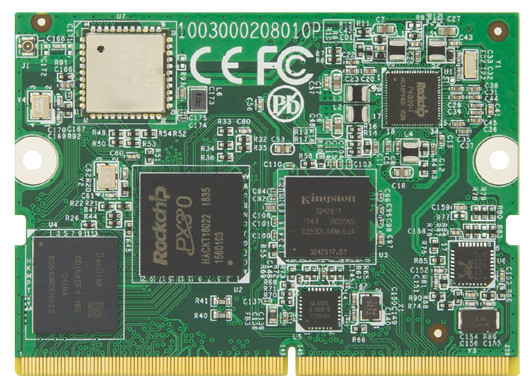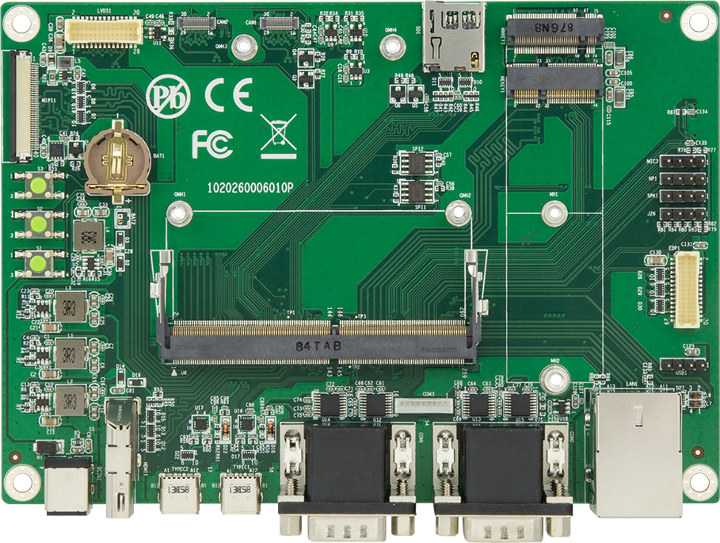Rockchip PX30 is a quad core Cortex-A35 processor with a dual VOP (Video Output Processor) in order to drive two independent displays, that has low power consumption, low thermal requirements, and that we previously found in some car infotainment systems.
But the processor is also suitable for other applications, and ARBOR Technology recently launched SOM-RP301 system-on-module based on the PX30 processor, and specifically designed for fanless retail kiosks such as electronic restaurant menus, automated currency exchange machines, ticketing kiosks and more.
 SOM-RP301 system-on-module specifications:
SOM-RP301 system-on-module specifications:
- SoC – Rockchip PX30 quad core Cortex-A35 processor @ 1.5 GHz with Arm Mali-G31 MP2 GPU
- System Memory – 1GB LPDDR3 (Up to 4GB as option)
- Storage – 16 GB eMMC flash
- Connectivity – Fast Ethernet transceiver, 802.11 b/g/n/ac WiFi 5 + Bluetooth 4.0 module
- Edge Connector – SO-DIMM connector with
- Display – LVDS or MIPI DSI
- Camera – MIPI CSI RX interface with 8MP ISP
- Audio – Support for 1W speaker (4 Ohms), 1x analog microphone, 1x digital microphone, and headphone out
- Networking – 10/100M Ethernet
- USB – 4x USB 2.0 port via USB hub
- Serial – 2x 2-wire UART ports, 2x 4-wire UART ports
- Analog – 3x 10-bit ADC up to 1MB/s sampling rate
- Misc – SDIO, GPIO, 2x SPI, 2x I2C
- Misc – RTC support
- Power Supply – 5V/1.5A
- Dimensions – 69.6 x 50 mm (“SOM-1-S” form factor)
- Temperature Range – Extended: -10 ~ 70ºC
- Humidity – 10% – 95% RH at 70ºC (non-condensing)
The company provides supports for buildroot, Ubuntu Linux, and Android 9.0 for the module.

ARBOR also offers a carrier board to get started with development.
PBA-9000-A SOM Family Carrier Board preliminary specifications:
- Storage – microSD card slot
- Display – HDMI, MIPI DSI, embedded DisplayPort (eDP)
- Camera – 2x MIPI CSI RX up to 13MP
- Audio – Headers for 2x 1W (@ 8Ω) speaker, 2x analog microphone, 1x digital microphone, 1x headphone out
- Networking – 1x Gigabit Ethernet RJ-45 connector
- USB – 4x USB 2.0 interfaces, 2x USB type-C ports
- Serial – 2x DB9 serial ports, UART header (COM3)
- Expansions – M.2 sockets, I/O ports with SDIO, 8-bit DI, 8-bit DO, GPIO, 2x SPI, 2x I2C
- Misc – 3x buttons, RTC support
- Power Supply – 5V/3A
- Dimensions – 165 x 115 mm
- Temperature Range – -20 ~ 70ºC
The carrier board is also compatible with the company’s newly launched SOM-RK391 system-on-module powered by Rockchip RK3399 SoC, and targeting AI computing, edge computing and machine vision applications.
You may find a few more details about the PX30 SoM, RK3399 SoM, and corresponding carrier board in the press release, and Arm-based computing platform page on ARBOR website.

Jean-Luc started CNX Software in 2010 as a part-time endeavor, before quitting his job as a software engineering manager, and starting to write daily news, and reviews full time later in 2011.
Support CNX Software! Donate via cryptocurrencies, become a Patron on Patreon, or purchase goods on Amazon or Aliexpress




